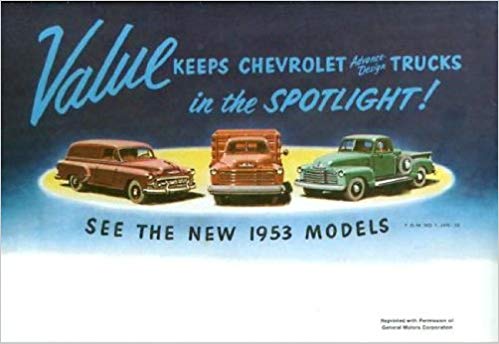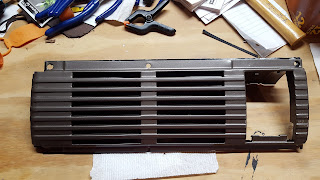Hello Gray Ghost Fans!
As the title suggests, this post is about the odds and ends that I've been working on as I make the final push to finish the electrical phase of the restoration. So here goes:
First off, I mentioned in the last post that I had finally settled on a location for the multiple ground wires. All of the wires were terminated with a ring connection. Once stacked and installed on the firewall, it looked like this:

In the pic, you can notice a couple of things. To the left is the shift linkage from the 3 on the tree shifter. On the ground stud you'll notice all of the ground wires have shrink tubing on them except for one of them. That one came pre-terminated, so I could't get the shrink tube onto it. It's really no big deal, I've just been uber cautious since everything in the truck is metal. I'm desperately trying to avoid any potential for a short, even going so far as to shrink tube the ground wires. The purple wire is from the starter and goes to the ignition switch. I'll have to tuck that up better and secure it.... The brown wire is for the heater. I think it is the power feed. If so, I think it'll go to the heater switch, once I buy one. For now, it too will get tucked up under the dash and out of the way. I'll have to restore the heater core before I buy the switch and wire it all up.
Second, I needed to restore the battery tray. This will be one of those things that if you don't see it, you really won't believe what I tell you. So hear it goes. The battery tray is located under the floor of the cab on the passenger side of the truck. It has 2 side pieces that are riveted to the truck frame and a center piece that the battery actually sits on and is riveted to each side piece. For whatever reason (battery acid, sitting in a field for years or both) the bottom of the battery tray was essentially gone when I got the truck. So, I needed to get the remnants of the bottom piece out so that I could put the replacement in. If I'm going to put a battery in the truck and fire up the electrical system, I do need a place to put it! Grinding off the rivet heads allowed me to remove the remnants. Once remove, it looked like this:

The rods sticking up are supposed to be threaded. They allow you to securely flange down the battery hold down, so that the battery doesn't move around when you are driving. Mine were pretty rusted, so I had to chase the threads. Once I did that, they looked quite functional.
When you look down into the opening, you can see where the rivet heads have been ground off. You'll also note that the rivets themselves are still in the side pieces. That is not for lack of trying! When the hot rivets are bucked into place, they expand to fill the entire space of the hole. So grinding of the heads and just using a punch and hammer doesn't always get them out. In this case, that is what happened. It looks like I'll have to drill out the rivet centers and hopefully relieve some of the pressure and then punch them out.
To give you an idea of just how little of the tray bottom remained, here is a pic that shows the bottom remnants with the replacement bottom.
Literally, there is a side part on the left and only where the rivet was on the right. Everything else was gone! But that's ok. The replacement part is very heavy duty, fits the space and the holes line up with the rivets. So, once the rivets are gone, it's just a matter of bolting in the replacement piece. I'm not going to try to rivet it right now. If I ever get to do a frame off restoration, I might rivet it. Maybe.
The other big project that I finished up has to do with the dash. My truck did not originally have a radio, which was common back in the day. It was meant for working, not listening to the radio. So Chevrolet filled in the hole in the dash with what's called a "radio delete plate". I have the original radio delete plate and have already restored it some time ago. I was just waiting on enough progress with the wiring before buttoning up the holes in the dash, as they are quite handy to have while the wiring is ongoing.
In the meantime, I had an issue with the wire harness: where to put the turn signal dash indicator lights. The gauges that I bought do not have them. The truck did not originally have any, as turn signals were an aftermarket add on. Then I got the idea, put them in the radio delete plate! That space gives me enough area to add both turn signal indicator lights
PLUS the high beam indicator light
PLUS some kind of small emblem! Awesome! Now the search was on for just what emblem I would want. To give you an idea of space, the entire area of the radio delete plate that is visible through the dash is 5"L x 3"T. So it's not that much space, but enough. Some of the emblems that I considered included: 1. Chevrolet in script, 2. Pontiac Star Chief fender skirt star (I really liked this one but couldn't accept the pint of the star affixed to my dash...seemed kinda hazardous), 3. The Chevrolet chevron, 4. Early 60's Nova 6 Cylinder badge, 5. Early 60's Impala quarter panel badge (the one with the red, white and blue emblem, not anything that actually said "Impala") and 6. The 1950 - 1952 Chevrolet truck "3100" emblem. Let me just say that all of these were in true contention, but only one of them won out. Which will it be? Patience, Gray Ghost Fans! First to the process. Since my original radio delete plate was already restored, I didn't want to drill any holes in it. This meant that I would have to buy another one. No big deal. I won one on eBay and it looked like this:

Front
Back
Interesting side story: I looked up the company on the sticker and they still exist! If you go to their website, it has the company story which states that the founder of the company used to drive an old red pickup truck. Makes you think it might have been in that old truck?!!?
Of particular note, notice the notches in the plate. They align with similar holes and notches in the dash. This is important, because if you notice the back side of the bolts, they have a tab that locks into that slot. This keeps the bolt from spinning in the hole when you are trying to tighten it.
Clearly, this piece needed some sand blasting...so that's what I did. Afterward, it was time to lay out where I wanted the lights and emblem to go. I put down some painter's tape and did the layout on that. It looked like this:
And there's your clue, Gray Ghost Fans! Which emblem did I choose? Not yet! First here's a pic of the really cool LED lights that I'll use for the turn signal indicators:
I bought 2 of the green (one for left and one for right) and one blue (for the high beam indicator). They are 8mm wide (about 5/16"). Instead of searching for an 8mm drill bit, I went with the 5/16" bit and then reamed out the hole with a rat tail file. Worked perfectly. I guess it's time to let the cat out of the bag: the emblem that I chose is:
This is the 1950 - 1952 Chevrolet 3100 emblem. My truck is a 1953 model, so Chevrolet changed it up starting in my year. However, the style of number is consistent with my truck, so it fits right in. Here is a pic of the lights and emblem before installation:
All in all, only a couple of bucks and I think it'll work out pretty good.
After doing the layout, I drilled and reamed all the holes and did a test fit to see how it would work. The test fit looked like this:
I've got to say, not too shabby! Ok, test fit over. Time for paint! I painted the plate to match the dash, which means Rustoleum #7713 Dark Bronze. Once that was dry, I permanently installed the lights and emblem. It now looks like this:
I think it turned out pretty darned good! I offset the high beam indicator light just a bit so it sits just higher than the turn signal indicators. The 3100 emblem sits dead nuts in the middle (left to right) and the lights are equidistant from the edges of the emblem. I can't wait for the paint to cure completely so that I can install the plate in the truck. (If I do it now, the paint will scrape off the edges as I wedge it back into the dash.) Once I get it wedged into the dash, I will use those special bolts to bolt it into the dash and then make the electrical connections for the turn signals.
I'd love to know what you think about it!
That's all for now. I'm in the process of collecting parts necessary for the engine swap. In the meantime, I'll keep plugging along with smaller projects to try and keep it moving forward.


























